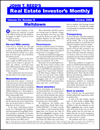John T. Reed’s review of Jay P. DeCima's
Fixin' Ugly Houses for Money


This originally appeared in Real Estate Investor’s Monthly newsletter. It also appears in my book, Fixers.
When I first got into this business in 1967, there were not many books on real estate, but the ones that existed were all good. I suspect the publishers had some standards back then. Lately, I have read dozens and dozens of real estate books that are near worthless. Finally, someone has come out with one that contains some original, useful material.
Rehab
Jay DeCima’s book, Fixin’ Ugly Houses for Money, does an excellent job of describing how to buy certain properties and increase their value by rehab. I hasten to add that a lot of the book is not excellent.
When I write a book review, I often find myself telling readers what the title should have been to more accurately reflect the book’s contents. Not this time. “Fixing ugly houses for money” is an accurate description of the book’s best parts.
DeCima’s strategy is to buy properties that have “the right things” wrong with them as long as they are not in really bad neighborhoods. He operates in Redding, California, an isolated city of 70,000 people 167 miles north of Sacramento.
Six houses on one lot
I once wrote an article about bargains in lots with two houses on them, one in the back yard of the other (12/88 issue). DeCima wrote me to tell of deals where he bought six on a lot, eleven on a lot, and nineteen on a lot. His book tells of other such properties, including one property with 21 run-down, old-time motor cottages.
Shunned properties
I have long said, and DeCima agrees, that the fixer strategy requires more than a house that “needs work.” You need to find properties so bad that other buyers shun them. Multiple houses on the same lot are an excellent example of such properties. (Multiple house on one lot don’t count if they all have street frontage. The extra houses must be “in the back yard.”)
‘…a Redding neck’
Comedian Jeff Foxworthy says, “If your have a home that’s mobile and 14 vehicles that are not, you might be a red neck.” DeCima repeatedly says that one of the best problems for a property to have is stuff that needs to be hauled away: junk cars, trash, and so forth. In 23 years of investing plus working as an agent and property manager, I only saw one haul-away opportunity—a probate house so full of junk that it overwhelmed the crew of church volunteers who reneged on their promise to clean it out.
DeCima also speaks frequently of having to evict “bikers.” To paraphrase Foxworthy, “If you renovate by hauling away junk and improve management by evicting bikers, you might be a Redding investor.” I do not know whether those particular techniques will get you very far elsewhere.
Picket fences
DeCima’s signature improvement is a white picket fence. Sounds good if the lot is not sloped. I would also want the fence to be made of plastic. Wooden fences are a pain to maintain.


Foundations
DeCima says foundation repair is more than he wants to tackle. That’s a mistake. See “Profit opportunities in bad foundations” in the 6/88 issue.
Better management
DeCima says you can accomplish a lot with better management, especially if the current owner has rented to tenants from hell. He’s right. I would add that you cannot replace the bad tenants in a building full of bad tenants one tenant at a time. You have to get rid of almost all the bad tenants before any good ones will move in. That causes a period of extended negative cash flow which must be accounted for in both your cash-flow planning and your profit calculations.
DeCima frequently asks for a six-month moratorium on mortgage payments when he first buys such buildings. Good idea. He should also get a moratorium on accruing interest. A payment moratorium without an interest moratorium isn’t worth much when it comes to making a profit.
Anti-intellectual
DeCima is big on the simple approach, which I also urge, but he carries it too far—to the point where it appears to be a general bias against intelligence. For example, on page 2 he says, “…it’s far better to be a little bit dumb about things and to act, than it is to be super intelligent and never accomplish anything!” There is such a thing as analysis paralysis. I put an article about it at my Web site (www.johntreed.com/analysysparalysis.html). But the “super intelligent” are not the only group afflicted by that syndrome.
Anti-computer
DeCima also reveals his anti-intellectual bias by dismissing computers.
Anyone who manages property without a computer needs his head examined. I’m not saying it can’t be done. All of us used to do it without computers. Computers give you far more useful information with far less effort. It’s also dumb to do heavy-duty number crunching without a computer.
I recommend no known canned real-estate-investment-analysis computer programs because they require you to make multi-year assumptions which are garbage in. I do recommend computer spreadsheet, word-processing, tax, and check-writing programs.


Time value of money
DeCima knows enough about the time value of money to say on page 117, “You don’t need to know the internal rate of return on a duplex to make a profit.” (That’s the first time the phrase “internal rate of return” has ever appeared in this newsletter.)
I agree with that statement, but DeCima apparently does not understand the time value of money because he repeatedly adds multi-year payment streams, like cash flow or mortgage payments, arithmetically to show what huge profits he made.
I hope everyone reading this newsletter already knows that the sum of a multi-year stream of payments is a grossly inflated and near meaningless number when it comes to measuring investment performance. The correct way to look at multi-year payment streams is in terms of return on equity or interest rate.
Internal rate of return is also valid, but it’s too much trouble and tends to inflate value a little because it includes tax savings. To me, IRR is a gimmick investment Realtors® use to persuade buyers to raise their offers.
Positive cash flow
DeCima is a big advocate of positive cash flow from day one. Amen.
Installment sales
DeCima is also a big advocate of taking back a mortgage when you sell to get a higher price. That’s common, but still dumb.
He should apply his wise belief that “Cash is king” to the going as well as the coming. The reasons why you should never take back a mortgage when you sell are explained at length in my book How to Use Leverage….
For here, suffice it to say that the closing-day, cash resale values of the mortgages DeCima takes back are less than the amount of additional cash he would have received if he had cut his sale price to the all-cash-to-him sale-price level. The real reason sellers take back mortgages is that they don’t want to admit that their property is really not worth what they are asking.


Inaccuracies
DeCima’s book contains many inaccurate statements and exaggerations about public-domain information. For example, he says of partnership structures, “Also remember, there is (sic) absolutely no limits to how creative you can be! [emphasis in original]”
That’s not true. There are all sorts of limits on partnership structures in state/federal tax law, securities law, state law on tenancies in common, state laws on husband-wife ownership, state laws on general and limited partnerships. He also takes sole credit for things he got from others.
His many errors and reluctance to share credit make me wonder if he’s been somewhat less successful than he claims and if he has had more help from external forces than he admits.
‘Buying back mortgage debt for bonus profits’
DeCima is big on buying back the mortgage on your property at a discount. In How to Use Leverage…, I said you should try to get a prepayment bonus whenever you pay off a below-market-rate mortgage early.
In his discussion of prepayment bonuses, DeCima says you have to find property which is encumbered by private, assumable mortgages. Say what? There may be such things in Redding, CA, but I have rarely come across private, assumable mortgages in my 30 years in the business. Landlording author Leigh Robinson tells me they are sometimes seen in mobilehome park sales.
Four mortgages
On page 343, DeCima gives a sample deal which he describes as “…excellent terms for a buyer.” The buyer pays $300,000 putting 10% down, assuming three existing private mortgages of $85,000, $50,000, and $35,000, each of which had been placed on the property during three separate past sales. Furthermore, the seller took back a fourth mortgage for $100,000 for 20 years.
I would be amazed if you could find one private, assumable mortgage in a career. Three on one property seems as frequent an event as an alignment of planets.
Also, DeCima leaves out the monthly payments. But it is generally true that a stack of separate, short-term remaining mortgages would have an extremely high constant. The constant is the total annual payments divided by their total balances. On one mortgage, the constant, stated as a percentage, is normally slightly higher than the interest rate because it contains only a small amount of principle.


But when you stack four mortgages created over many years on one property, the most recent only a 20-year term, the payments are likely to include large components of nondeductible principle and relatively small interest amounts. That makes the total payments so great in relation to the amount owed that the payments probably far exceed the property’s net income. These are not “excellent” terms. They are most likely impossible terms.
Six years to live?
In an attempt to explain the motives of older mortgage holders, DeCima becomes an actuary—an incompetent one. On page 346, he says a 67-year-old guy who took back a mortgage has only six more years to live because the life expectancy of a man is 73 in the U.S. Actually, that 73-year life expectancy was for babies born 73 years ago at the time of birth.
As of 1979 (date of my almanac), a person aged 65 had a remaining life expectancy of 16.7 years; at 70, 13.5 years. That would give a 67-year old 15.4 more years to live, not six.
Doing your homework
DeCima appears to have decided not to spend much of his life getting a formal education. That’s a legitimate choice. But once one has made a decision not to do homework, he ought to refrain from lecturing on the subjects which he decided not to study.
DeCima’s book’s scope spans numerous disciplines, including law, actuarial science, and finance. It is an expanse of intellectual territory over which few college professors would claim expertise. DeCima has a School of Hard Knocks Ph.D. in fixup, but on most of the other topics he covers in this book, he doesn’t know what he is talking about and gives his readers many bum steers as a result.
DeCima’s book inspired me to add a “Common misconceptions about real estate investment” page to my Web site.